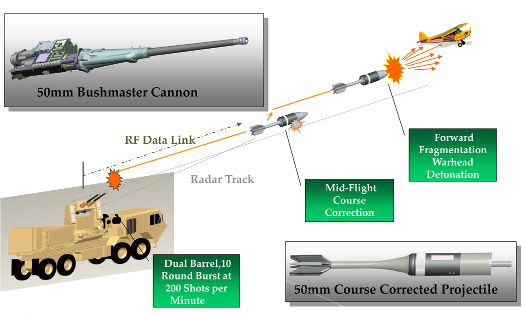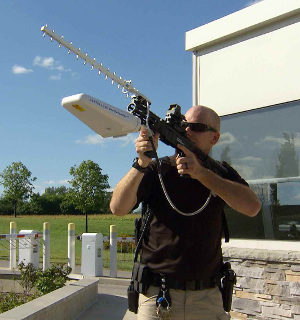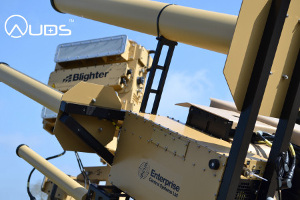 |
| January 05, 2016 | Volume 12 Issue 01 |
Designfax weekly eMagazine
Archives
Partners
Manufacturing Center
Product Spotlight
Modern Applications News
Metalworking Ideas For
Today's Job Shops
Tooling and Production
Strategies for large
metalworking plants
Army, commercial engineers demonstrate anti-drone technology
Main story by Edward Lopez, Picatinny Arsenal, NJ
Army engineers, who are seeking to adapt ongoing research to counter aerial systems that could threaten Soldiers, successfully shot down two aircraft as part of their final technology demonstration at Picatinny Arsenal, NJ, recently.
Although the research project began with the objective to counter rockets, artillery, and mortars, the project scope was expanded to include threats from unmanned aerial threats, sometimes called drones, whose use has expanded rapidly.
"It's unbelievable how much it's exploded," said Manfredi Luciano about the use of drones.

The operational concept behind the Enhanced Area Protection and Survivability technology is to have a 50-mm course-corrected projectile intercept an incoming threat. The warhead has a tantalum-tungsten alloy liner to form forward-propelled penetrators for defeat of rockets, artillery, and mortars while steel-body fragments are designed to counter unmanned aerial systems. [Photo Credit: U.S. Army illustration]
"Every country has them now, whether they are armed or not or what level of performance. This is a huge threat (that) has been coming up on everybody. It has kind of almost sneaked up on people, and it's almost more important than the counter-RAM threat."
Luciano is the project officer for the Enhanced Area Protection and Survivability, or EAPS, Army Technology Objective. The technology is being developed by the U.S. Army Research, Development and Engineering Center, or ARDEC, at Picatinny Arsenal. Funding for development and testing was provided by the ARDEC Technology Office.
The challenge has grown exponentially in the last decade as the world's inventory of unmanned aircraft systems, or UASs, has grown from approximately 20 system types and 800 aircraft in 1999, to more than 200 system types and approximately 10,000 unmanned aircraft in 2010, said Nancy Elliott, a spokeswoman with the U.S. Army's Fires Center of Excellence on Fort Sill, OK.
Although a missile-based Counter Rocket, Artillery, and Mortar, or C-RAM, defense system has been selected as the technical approach for the Indirect Fire Protection Capability Increment 2 Intercept Program of Record, the gun alternative continued to mature as force-protection technologies for other potential applications.
During the final testing Aug. 19 at Yuma Proving Ground, AZ, engineers shot down two class 2 UASs using command guidance and command warhead detonation. The UAS was an outlaw-class aircraft, a product of Griffon Aerospace, and the intercept engagements occurred at over a kilometer range and about 1,500 meters.
The first shoot-down at the kilometer range was a replication of the test performed April 22, in which the EAPS technology first successfully intercepted a loitering UAS. Some fire-control improvements were made after the April 22 tests, and were validated during the Aug. 19 testing. The second shoot-down was executed at a 50 percent greater range and exceeded the EAPS demonstration objectives.
The EAPS ARDEC gun alternative to area protection envisions a 50-mm cannon to launch command-guided interceptors. The system uses a precision tracking radar interferometer as a sensor, a fire control computer, and a radio frequency transmitter and receiver to launch the projectile into an engagement "basket."
"In order to minimize the electronics on board the interceptor and to make it cheaper, all the 'smarts' are basically done on the ground station," Luciano said. "The computations are done on the ground, and the radio frequency sends the information up to the round."
The Picatinny area-protection system tracks both the incoming threat and interceptor, then computes an ideal trajectory correction for the interceptor to maximize probability of mission success. A thruster on the interceptor/projectile is used for course correction. The ground station uplinks the maneuver and detonation commands while receiving downlinked assessment data.
The interceptor takes the commands and computes the roll orientation and time to execute thruster and warhead detonation. The warhead has a tantalum-tungsten alloy liner to form forward propelled penetrators for defeat of C-RAM targets, and steel body fragments to counter unmanned aerial systems. C-RAM stands for counter rockets, artillery, and mortars.
The integrated test demonstrated a proof-of-principle that direct-fire, command-guided ammunition can intercept and negate aerial threats, Luciano said. Technologies from the EAPS gun alternative Army Technology Objective, or ATO, may potentially be used for both Army and Navy air defense systems, he said.
The August testing concludes the EAPS Gun ATO. ARDEC now awaits counter-UAS requirements. Once requirements are generated and approved, the technologies developed under EAPS can be configured to a new design for a future tactical system.
The EAPS fire-control radar interferometer was designed, fabricated, and operated by Technovative Applications in Brea, CA. Radar interferometers use multiple receive antennas to enhance angular measurements for centimeter tracking accuracy.
Design of the 50-mm cartridge/interceptor was a collaborative effort between ARDEC engineers and Orbital ATK, Armament Systems Division in Plymouth, MN. Interceptors were assembled by Orbital ATK and warheads by Aerojet Rocketdyne in Sacramento, CA. The fire-control algorithm was a collaborative effort by the various subject matter experts but led and written by Propagation Research Associates, Inc., in Atlanta.
The EAPS Integrated Product Team was led by ARDEC's Munitions Systems and Technology Directorate at Picatinny Arsenal.
Sidebar: The not-so-big 'guns'
By Mike Foley, Designfax

Battelle's DroneDefender.
When it comes to neutralizing drones, sometimes you don't need the big guns. In fact, sometimes you don't need a gun at all.
Many companies around the world are rolling out drone busters with paralyzing or immobilizing radio-frequency or laser technology. Three standouts are the DroneDefender by Battelle (Columbus, OH), the Anti-UAV Defense System (AUDS) put together by a trio of companies in the UK, and the Compact Laser Weapons System from Boeing.
Battelle's DroneDefender is a portable, rapid-to-use counter-weapon to stop suspicious or hostile drones in flight. It uses radio control frequency disruption technologies to gain control of a drone and immobilize it -- hopefully before it can pose a threat to military or civilian safety.
The point-and-shoot system has a demonstrated range of 400 meters and an active area that covers a 30-degree cone. It provides instant threat mitigation to minimize drone damage and the risk to public safety. Each unit features two antennas, a software-defined radio, and jamming circuitry. The unit has a cold start time of <0.1 seconds and an operating time of five hours continuous. It weighs less than 10 lb, depending on how it is configured.
If you need something a little more heavy-duty, the AUDS (Anti-UAV Defense System) is designed to disrupt and neutralize UAVs engaged in hostile airborne surveillance and potentially malicious activity. The AUDS system combines electronic-scanning radar target detection, electro-optical (EO) tracking/classification, and directional RF inhibition capability. It can track 24/7 in all weather conditions and has a detection range of almost 5 miles.

AUDS (Anti-UAV Defense System).
The AUDS Team brings together three leading British companies, each with the unique capabilities required to create an effective counter-UAV system. Blighter's A400 series air security radars are able to detect small UAVs in all weather conditions, 24 hours a day.
The Chess Dynamics Hawkeye EO/IR camera system, with state-of-the-art video tracking technology, is able to TRACK the UAV and, combined with radar target information, classify the target. The operator is then able to make a timely and informed decision to use the Enterprise Control Systems (ECS) smart RF inhibitor to selectively interfere with the C2 channels on the UAV, allowing the system to disrupt the UAV's mission. This system is sold through Liteye in the USA.
It features a high-gain quad-band antenna system, thermal and HD cameras, digital video detector and tracker, software defined intelligent RF inhibition, and many other useful bells and whistles. The makers did not provide RF output power. A Liteye rep says that this solution has inhibited UAVs at 2.5 km, but the maximum range is classified. Units are in full production and shipping; systems are deliverable in 90 days.
And if you really just want to get 'er done without all the niceties of seizing a UAV and gently guiding it to the ground, the hands-on favorite pick is the Boeing Compact Laser Weapons System with its powerful "fly and fry" technology. This 650-lb unit sets up in minutes and is ready to send its energy-directed blast in seconds.
According to Boeing, the system recently reached a milestone at an exercise at Point Mugu, CA, by tracking and disabling a moving, untethered unmanned aerial vehicle in 15 seconds. The unit's main aim is to send concentrated energy to a single spot, disabling the drone mid air (translation: toasting it). The system is made up of a battery, a water-cooled chiller, a commercially available fiber laser, and a beam director that can direct a beam with a power up to 10 kW. It can track targets at tens of miles -- automatically -- and take over for a human operator if desired.
And the best part is it costs nearly nothing to operate, since it uses electricity supplied by a standard 220-V outlet, generator, or even a battery pack.
Published October 2015
Rate this article
View our terms of use and privacy policy
